|
|
Dear Colleagues
We are facing the second pandemic autumn while we are still trying to cope as well as we can with the COVID-19 restrictions, to ensure operation of our large-scale research facilities and smooth running of our successful user programmes at PSI. I was very impressed to see the strong motivation and great flexibility of all technical and scientific staff who made it possible to successfully complete extensive shutdown works as well as to restart the accelerators and facility instruments earlier this year.
|

Thomas Prokscha
|
|
All this happened with a maximum of 50% of staff allowed on site. During this challenging time, our young researchers — the PhD students and postdocs — received priority access to the labs and instruments, to be able to continue their research work with as little delay as possible.
Although many of the restrictions at PSI were removed starting from the beginning of July, travel to Switzerland is still limited due to various international regulations. Many users cannot travel to PSI, and a significant number of experiments has to be carried out remotely. This means an additional load on our PSI research scientists in organizing and running the experiments. I am grateful to my colleagues and all administrative, technical, and scientific staff at PSI for their outstanding commitment in helping to keep our exciting research activities going.
I hope that life will get easier next year, and that we can welcome all of our users back to PSI.
Thomas Prokscha
on behalf of the Laboratory for Muon Spin Spectroscopy LMU, NUM division
|
|
Next proposal submission deadlines:
SLS: PX beamlines
deadline: October 15, 2021
more information
SINQ
deadline: November 15, 2021
more information
SµS
deadline: December 6, 2021
more information
CHRISP
deadline: January 10, 2022
more information
SwissFEL
deadline: March 15, 2022
more information
SLS: non-PX beamlines
deadline: March 15, 2022
more information
An overview of all proposal submission deadlines of the PSI facilities can be found here.
|
|
|
Materials engineering of violin soundboards by Stradivari and Guarneri
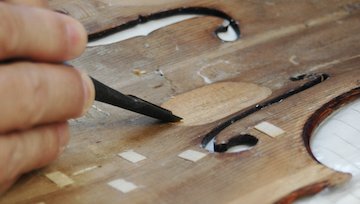 SLS — Secrets of Cremonese violins revealed SLS — Secrets of Cremonese violins revealed
The old Italian master violin makers Antonio Stradivari and Guarneri del Gesù relied on unexpected chemical additives to bring forth the extraordinary sound of their instruments. This has been revealed by an international team of researchers in experiments covering a wide range of spectroscopic, microscopic, and chemical techniques, including X-ray spectroscopy at the PHOENIX beamline of SLS. The researchers studied wood shavings left over from repairs of the valuable violins and found unnatural elemental compositions and oxidation patterns in the spruce wood used. These suggest artificial manipulation before the mechanical work, for the purpose of wood preservation or acoustic tuning. The extensive treatment included borax and metal sulfates (possibly for fungal suppression), table salt (for moisture control), alum (for molecular crosslinking), and potash or quicklime (for alkaline treatment).
Read the full story |
|
|
C.-K. Su et al., Angewandte Chemie International Edition 60, 19144 (2021)
|
|
|
Kinetics of water-vapour uptake into a sessile water droplet
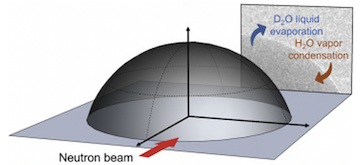 SINQ — High-resolution imaging of liquids at non-equilibrium SINQ — High-resolution imaging of liquids at non-equilibrium
Evaporation and condensation at liquid–vapour interfaces are ubiquitous mass-transport phenomena that are of interest both for basic studies and industrial applications. However, existing in-situ methods encounter important limitations when it comes to assessing the spatiotemporal distribution of multiple components and phases. Fresh insights could come from high-resolution neutron imaging, as proof-of-concept experiments at the ICON beamline of SINQ demonstrate. The team made use in particular of the large difference in neutron cross-section between hydrogen and its physicochemically similar isotope deuterium, and thus quantitatively characterized how a sessile 7.7-ml heavy-water droplet evaporates while absorbing light-water vapour from the ambient air — monitoring in situ both geometrical changes of the droplet and its H 2O–D 2O fraction, at a resolution of ~20 μm and 60 s per frame.
Read the full story |
|
|
J.K. Im et al., Matter 4, 2083 (2021)
|
|
|
Chiral singlet superconductivity in the weakly correlated metal LaPt3P
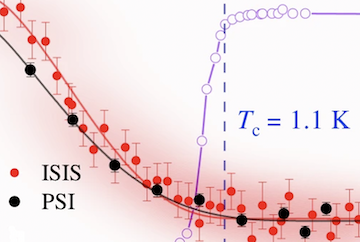 SμS — An intriguing outlier SμS — An intriguing outlier
Within the family of platinum pnictide superconductors, LaPt 3P is quite an outlier. Its transition temperature of 1.1 K is significantly lower than that of its two isostructural counterparts SrPt 3P and CaPt 3P. And whereas the latter two are conventional Bardeen–Cooper–Schrieffer superconductors, LaPt 3P is not. The nature of its unconventional superconductivity remained, however, unresolved. Now, in a comprehensive μSR study performed at PSI and ISIS (UK) an international team of researchers has established that LaPt 3P is a rare example of a chiral singlet superconductor. They observed spontaneous time-reversal symmetry breaking in the superconducting state at T c, with line nodes in the superconducting order parameter. These findings are shown to be consistent with a chiral d-wave singlet superconducting ground state in LaPt 3P with topologically protected Majorana Fermi arcs and a Majorana flat band.
Read the full story |
|
|
P.K. Biswas et al., Nature Communications 12, 2504 (2021)
|
|
|
Combining far-infrared excitation with X-ray probes at cryogenic temperatures
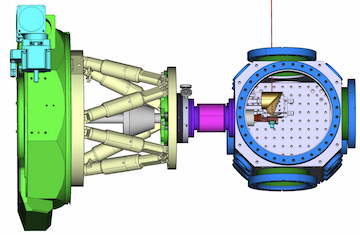 SwissFEL — New insights into correlated materials in the time domain SwissFEL — New insights into correlated materials in the time domain
At the Bernina endstation of the hard X-ray beamline Aramis, a chamber optimized for high-field THz excitation and (resonant) X-ray diffraction at sample temperatures between 5 and 500 K has been commissioned. The chamber is directly connected to the beamline vacuum and features a Beryllium window and an in-vacuum detector covering the full 2–12.7-keV energy range of the femtosecond X-ray pulses available. This means that absorption edges ranging from M (Dy to U), L (Rb to Tl) to K (P to Se) can be accessed. The ability to perform such element-specific experiments in a cryogenic sample environment should enable a variety of time-domain studies of correlated materials. The new capabilities were highlighted in commissioning experiments tracking selectively the dynamics of the structural, magnetic and orbital order of Ca2RuO4 and Tb2Ti2O7 at the Ru (2.96 keV) and Tb (7.55 keV) L-edges, respectively.
|
|
|
R. Mankowsky et al., Journal of Physics: Condensed Matter 33, 374001 (2021)
|
|
|
Review of Particle Physics at PSI
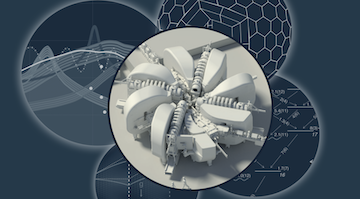 CHRISP — All the key results in one place CHRISP — All the key results in one place
Particle-physics results of lasting value and significant impact have been obtained at PSI over the past decades, and several efforts are presently ongoing and expected to deliver new findings in the near future. The results of these studies have been published in numerous articles and journals over the years, and many have found their way into the Particle Data Group review. However, in order to collect the scientific output of particle physics experiments at PSI's high-intensity beams of pions, muons and ultracold neutrons in one place, a special SciPost volume, entitled “Review of Particle Physics at PSI”, has recently been completed, containing also a description of the facilities. Ideas for future facility upgrades or completely new experimental efforts are not yet included, but there are plans to extend this volume in the years to come.
|
|
|
C. Hoffman, K. Kirch, A. Signer (eds), SciPost Phys. Proc. 5, 001-031 (2021)
|
|
|
News from the user facilities
|
|
|
LamNI - High-resolution 3D X-ray laminography
SLS
The established instruments for high-resolution 3D ptychography are complemented by LamNI ( Laminography Nano Imaging), which operates in laminography geometry rather than tomography. It allows the measurement of extended flat specimens. An area of 10x10 mm 2 is accessible with the setup, and the measurement position and size can then be freely selected.
We have demonstrated high-resolution ptychographic X-ray laminography (PyXL) by measuring an integrated circuit where the only sample preparation was to polish the substrate for achieving sufficient transmissivity. The demonstrated 3D resolution was 18.9 nm, measured in a circular area of 40 μm. PyXL has also proved beneficial for imaging with magnetic contrast via X-ray magnetic circular dichroism. In this case the experimental geometry allowed for in-situ studies of domain wall dynamics. LamNI is now open to user proposals at the cSAXS beamline. Please discuss your project with beamline staff prior to submission. |
|
Instrument upgrade program making good progress
SINQ
After a successful commissioning phase, the multiplexing spectrometer CAMEA welcomes first users in the current cycle. The high-performance 2D detector for the DMC diffractometer was delivered and assembled, and enters now the test phase. First test measurements are planned towards the end of the year. The Selene guide system, chopper, polarizer and spin flipper for the reflectometer AMOR have successfully passed the tests and show the expected performance. The team is now working hard to complete the upgrade of the secondary part of the instrument.
|
|
Microwave pump – muon probe experiments
SμS
Time-resolved pump–probe experiments provide valuable insight into the out-of-equilibrium response of a system. Such experiments become now feasible at the GPS instrument, thanks to pulsed microwave excitation during μSR observation. A key feature is that microwave pulses can be injected at variable times relative to the muon arrival time. This enables schemes such as two-pulse sequences where the first pulse excites the system and the second one returns it back to the initial state. Repeating the experiment with different delays between pulses and comparing the μSR signal before the first and after the second pulse, we can obtain insight into the time evolution of the microwave-excited state. For states that undergo phase-coherent microwave oscillations, this procedure yields Ramsey interference fringes. Such fringes have been observed in pilot experiments with muonium, a system with coupled paramagnetic electron and muon spin. Besides bespoke Ramsey fringes, various other excitation schemes become feasible with this novel tool, extending the capabilities of μSR to addressing open scientific questions regarding driven systems.
|
|
First light at Furka
SwissFEL
In another milestone on the path to full operation of SwissFEL, the Furka experiment station at the soft X-ray beamline Athos has seen ‘first light’. Diffraction and absorption test experiments are currently under way, and first scientific experiments with external users are planned for 2022. Whereas at the other experiment station of Athos, Maloja, work focusses on liquid and gaseous samples (Maloja has seen first light in mid-2020 and is now open for users), Furka is dedicated to the study of solid quantum materials using time-resolved resonant inelastic and elastic X-ray scattering (tr-RIXS and tr-REXS) as well as X-ray absorption (tr-XAS) spectroscopy.
More information |
|
Helium cooling system for the Mu3e experiment
CHRISP
For the first time all the core components of the Mu3e experiment were all gathered at the πE5 beamline and operated in concert. The pixel vertex detector, a core component of Mu3e, produces up to 110 W of dissipated heat. To keep the temperature controllably below ~50°C, a novel cooling principle using gaseous helium at ambient pressure is used. This system has been developed over the past few years in a highly successful collaboration between PSI, the University of Applied Sciences Northwestern Switzerland at Brugg-Windisch, and industrial partners. The prototype setup uses a custom turbo compressor from the Swiss company Celeroton to propel a closed-loop helium flow of 2 g/s (11 L/s) at up to 240,000 rpm. The differential pressure across the loop was only around 40 mbar and cooling was maintained successfully for the full operation period, thus reaching an important milestone. |
|
JUSAP - The Joint Users Association:
|
|
Dear Colleagues
The JUSAP board autumn meeting will take place soon. We encourage all members of the PSI user community to contact us regarding any issues that concerns user operation at PSI.
The obligation for PSI users to present a certificate of a negative PCR or rapid antigen tests introduced in May can be replaced since July by a full COVID-19 vaccination with the last dose received at least two weeks prior to your arrival date at PSI. The vaccination must be certified with an official document. Please look at the updated information.
|
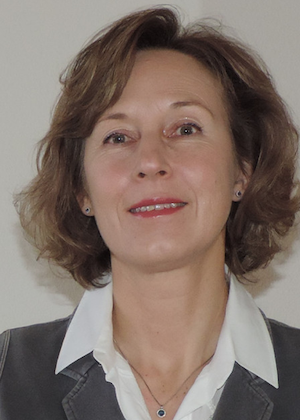
Joanna Hoszowska
|
|
We remind you of the proposal deadlines for the October to December period: October 15 for SLS Protein Crystallography beamlines (PX), November 15 for SINQ, and December 6 for SμS, see above.
The European synchrotron and FEL user organisation (ESUO) has recently launched a short questionnaire, with the aim to better understand the possible impacts of the absence of transnational access (TNA) funding support for the user community. Indeed, with the end of the CALIPSOplus project at the end of October 2021, TNA will no longer be able to be funded via the project. This may cause severe problems for many facility users. Please read more about the context and the aim of the survey and complete the short questionnaire accessible here. Inputs will be collected until October 13 (extended deadline). We thank you very much in advance for your participation and support.
Moreover, another recent ESUO activity concerns the transformation of ESUO into a legal entity based on Belgium law, which has been achieved on July 12 with the incorporation of the ESUO international non-profit association (ESUO-AISBL) made by notarial deed.
The Swiss Academy of Sciences (SCNAT) has recently published the Swiss Roadmaps for Research Infrastructures for the years 2025-2028. Among others there are Roadmaps for Photon Science, Neutron Science and Particle Physics authored/co-authored by the Swiss Societies for Photon Science (SSPh), Neutron Science (SNSS) and by the Swiss Institute for Particle Physics CHIPP, respectively. The Societies are open to everybody interested in the topics represented. For further information or to become a member please visit the websites linked above.
Yours sincerely,
The JUSAP committee
|
|
|
|